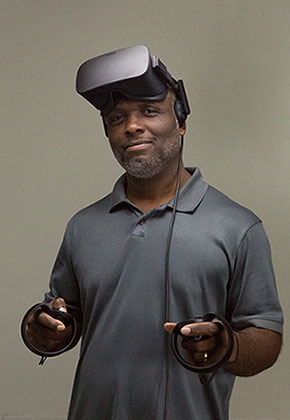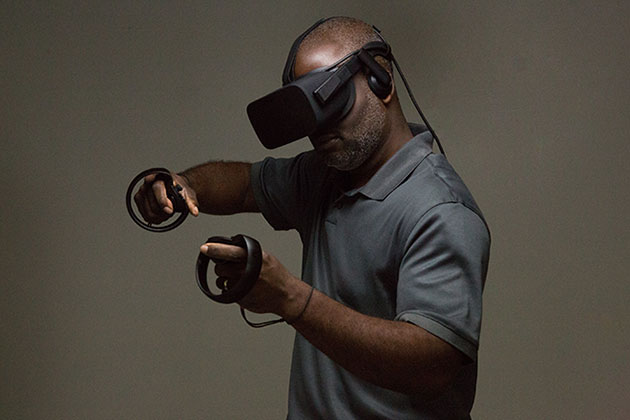Professor McArthur Freeman Explores New Possibilities in Art
Wednesday, November 15, 2017

Professor McArthur Freeman wears his virtual reality (VR) equipment. He views VR as an art medium that can completely transform the way stories are told.
McArthur Freeman, assistant professor of animation and digital arts at the USF School of Art and Art History, works as an artist and educator at the exciting confluence of art and emerging technologies.
In both practice and pedagogy, Freeman embraces an approach that blends formal concepts with digital technologies such as 3D printing, 3D scanning, and digital modeling in ways that are full of limitless potential.
"The thing is, we haven't even started to scratch the surface of what's possible with these technologies," said Freeman. "And having students aware of that and aware that they can get their hands on them can dramatically change their trajectory."
Freeman teaches classes on animation and digital modeling within the School of Art and Art History's Video, Animation, and Digital Arts (VADA) studio. Since joining the School in 2012, Freeman has played a pivotal role in designing curriculum and acquiring the necessary equipment for animation and digital modeling.
Today's animation and digital modeling curriculum includes Freeman's classes in 2D animation, 3D animation, digital modeling, digital sculpting, and digital fabrication. Other classes include theme classes on toys as art as well as compositing, a class about the combination of live video and animation. In the animation studio are three 3D printers ─ two MakerBot printers and a Form 1.
Animation and digital modeling students at the University of South Florida begin with a Video, Animation, and Digital Arts class before moving onto introductory level classes that establish foundation skills such as visual storytelling, cinematography, storyboarding, how to draw on the computer, and principles of animation.
Then come the intermediate classes of 2D and 3D animation where students learn the mechanics of motion, character design, and acting with characters. Project-driven animation studio classes allow students to specialize and collaborate with other students to fulfill all aspects of the production pipeline. Upper-level coursework operates by proposing projects, receiving feedback along the way while being self-driven and focused from beginning to end.
As an artist, Freeman's work revolves around 3D sculpting and working on the computer. He regularly relies on a variety of digital technologies, including 3D modeling, 3D scanning, photogrammetry, 3D printing, CNC routers, and virtual reality (VR).
Still, he maintains a close relationship with conventional sculpting materials such as wood, clay, bronze, and other materials. Freeman's current projects include a series of bronze castings, of which he hopes to create thirty by the end of the year. Additionally, he is working to create immersive and interactive VR environments.

McArthur Freeman sculpts with a virtual reality (VR) headset and controllers to create both fabricated sculptures and immersive, interactive 3D virtual environments alike.
Freeman didn't always make art how he does today. He grew up with a love for drawing,
and in his undergraduate studies, he studied painting and drawing as well as graphic
design. Eventually, he got into modeling on the computer, finding the relationships
between elements as similar to drawing, while also using a similar instrument – a
tablet and stylus. He feels he is not the only artist who has "started at the simulation."
"At this point, you have people who learn painting not from working with oil paints,"
said McArthur. "They learn from working on the computer with pixels."
Furthermore, he argues that his current practice is about more than simply the usage
of new tools.
"Tools and technology create new ways of thinking," said Freeman. "They are not just
tools, we create tools and so forth, but then the tools also play a role in transforming
us."
Students who study art with a concentration in animation and digital modeling at USF
can work in a variety of fields after graduation. Naturally, students can go on to
work as animators in the film and video game industry. They can also do applied 3D
scanning for movies and architects, digital modeling projects, and a variety of other
contexts where they can apply their skills in making images on the computer, modeling,
3D printing and more.
"They can do something that no one else has ever done. They can literally create new
and unexpected directions to explore."